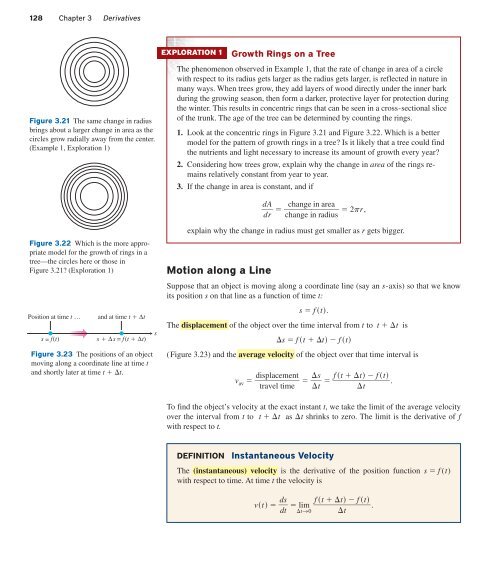5128_Ch03_pp098-184
Create successful ePaper yourself
Turn your PDF publications into a flip-book with our unique Google optimized e-Paper software.
128 Chapter 3 Derivatives<br />
Figure 3.21 The same change in radius<br />
brings about a larger change in area as the<br />
circles grow radially away from the center.<br />
(Example 1, Exploration 1)<br />
EXPLORATION 1<br />
Growth Rings on a Tree<br />
The phenomenon observed in Example 1, that the rate of change in area of a circle<br />
with respect to its radius gets larger as the radius gets larger, is reflected in nature in<br />
many ways. When trees grow, they add layers of wood directly under the inner bark<br />
during the growing season, then form a darker, protective layer for protection during<br />
the winter. This results in concentric rings that can be seen in a cross-sectional slice<br />
of the trunk. The age of the tree can be determined by counting the rings.<br />
1. Look at the concentric rings in Figure 3.21 and Figure 3.22. Which is a better<br />
model for the pattern of growth rings in a tree? Is it likely that a tree could find<br />
the nutrients and light necessary to increase its amount of growth every year?<br />
2. Considering how trees grow, explain why the change in area of the rings remains<br />
relatively constant from year to year.<br />
3. If the change in area is constant, and if<br />
d A change<br />
in area<br />
2pr,<br />
dr<br />
c hange<br />
in radius<br />
Figure 3.22 Which is the more appropriate<br />
model for the growth of rings in a<br />
tree—the circles here or those in<br />
Figure 3.21? (Exploration 1)<br />
Position at time t …<br />
s = f(t)<br />
and at time t Δt<br />
s Δs = f(t Δt)<br />
Figure 3.23 The positions of an object<br />
moving along a coordinate line at time t<br />
and shortly later at time t t.<br />
s<br />
explain why the change in radius must get smaller as r gets bigger.<br />
Motion along a Line<br />
Suppose that an object is moving along a coordinate line (say an s-axis) so that we know<br />
its position s on that line as a function of time t:<br />
s f t.<br />
The displacement of the object over the time interval from t to t Dt is<br />
s f t t f t<br />
(Figure 3.23) and the average velocity of the object over that time interval is<br />
v av d isplace<br />
travel<br />
ment<br />
time<br />
s<br />
f t t f t<br />
.<br />
t t<br />
To find the object’s velocity at the exact instant t, we take the limit of the average velocity<br />
over the interval from t to t Dt as Dt shrinks to zero. The limit is the derivative of f<br />
with respect to t.<br />
DEFINITION<br />
Instantaneous Velocity<br />
The (instantaneous) velocity is the derivative of the position function s f (t)<br />
with respect to time. At time t the velocity is<br />
vt d s<br />
lim<br />
dt<br />
f t t f t<br />
.<br />
t→0 t












